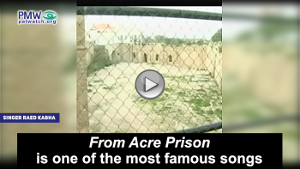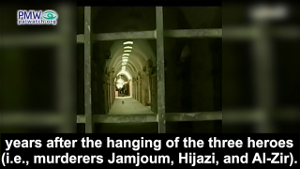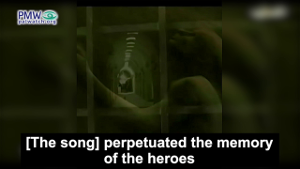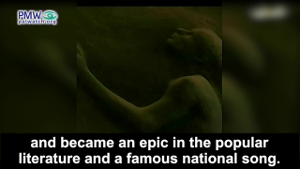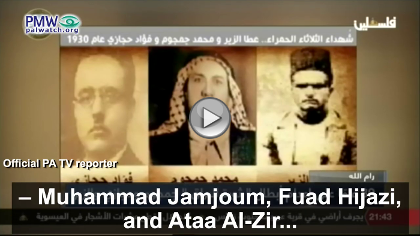"Brutal murderers" of Jews in 1929 massacre glorified as PA heroes
“The heroes competed which of them would be executed first, and they were a symbol and example of defiance and self-sacrifice, of heroism and daring” – official PA TV
Following the 1929 Arab Riots in which 65 Jews were massacred on one day in Hebron and dozens more in Safed, the British Mandate sentenced numerous Arabs to death. However, it “decided, in exercise of mercy… to commute the sentences in all but three cases, to penal servitude for life... The three Arabs whose sentences of death were carried out had committed particularly brutal murders [of Jews] at Safed and Hebron.” [British Gov. to League of Nations, Dec. 31, 1930]
Those three, Muhammad Jamjoum, Fuad Hijazi, and Ataa Al-Zir, were executed by hanging by the British in 1930.
This year marks the 90th anniversary of their execution and official Palestinian Authority TV, the PA news agency WAFA, the former PA Minister of Education, and Fatah all celebrated and glorified the three murderers of Jewish civilians as “heroes” and “role models.” For years, the three have been repeatedly portrayed as eager to sacrifice themselves for “Palestine” – even “competing” over who would be hanged first. The PA reiterated this legend this year:
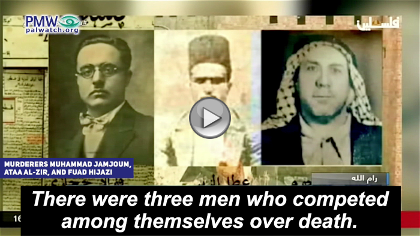
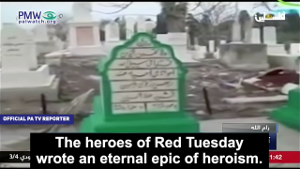
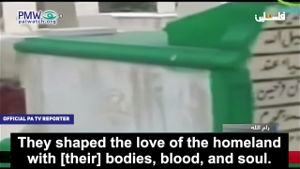

Official PA TV reporter: “The heroes of Red Tuesday wrote an eternal epic of heroism. They shaped the love of the homeland with [their] bodies, blood, and soul. They defied the prison guards and competed among themselves over the noose, rejoicing over Martyrdom-death. The heroes competed which of them would be executed first, and they were a symbol and example of defiance and self-sacrifice, of heroism and daring.”
[Official PA TV News, June 17, 2020]
The official PA news agency Wafa also honored the three murderers as ”fighters” and “heroes” in a long article, which did not even attempt to hide their gruesome deeds. It stated that “Arabs in Hebron killed 67 Jewish residents,” (exact number varies depending on sources –Ed.) and that 133 Jews were killed in total. It also noted the death toll of “116 Palestinian Martyrs.”
Wanting to concretize their “Martyrdom,” WAFA took a photo of three Syrian independence leaders being hung by Turkish Ottoman forces in 1916, and falsely presented it as the three “martyred” murderers being hanged by the British in 1930:

The PA further portrayed the three murderers as heroes by quoting letters they supposedly wrote before their execution. In the letters, the three express happiness over “giving their souls for the homeland.” This serves the PA in underscoring its message that death as a Martyr for “Palestine” is an ideal to strive for. Moreover, the three murderers stressed that people should rejoice over their execution and “persevere in Jihad for the redemption of Palestine from the enemies”:
Fuad Hassan Hijazi wrote: “The day of my hanging must be a day of happiness and joy, and it is a duty to celebrate and rejoice on June 17 every year. This day must be a historical day in which sermons are delivered and songs are sung in memory of our blood, which was spilled for the sake of Palestine and the Arab cause…
If the execution of us three to any extent destabilizes the English nightmare that is befalling the honorable Arab nation, then let tens of thousands like us be executed so that our nightmare will pass completely.”Ataa Al-Zir wrote: “Dance, mother, if news of my death reaches you. Dance and do not be sad on the day of my hanging. It does not matter what the enemy will do to my soul, mother, I am not leaving the homeland.”
Muhammad Khalil Jamjoum wrote: “As we stand at the gates of eternity and give our souls for the sake of the sacred homeland, for the sake of precious Palestine, we ask all the Palestinians that our blood that is spilled and our souls that will hover in the skies of this beloved land not be forgotten. Remember that we gave our souls and our skulls of our own free will, so that they would serve as a basis for the independence of our nation and its freedom. [We ask] that the nation will remain united and will persevere in its Jihad for the redemption of Palestine from the enemies.”
[WAFA, official PA news agency, June 16 and 17, 2020]
The article opened with a reference to a song about the three murderers, which still today is known by Palestinians:
“Most of us know the famous song by our poet Nouh Ibrahim, which the Palestinians have been singing for many decades and which opens with the words: ‘From Acre Prison went forth the funeral.’ This is one of dozens of songs and lamentations that were written following the execution of the three fighters.”
[WAFA, official PA news agency, June 16 and 17, 2020]
The song glorifying the murderers appeared on official PA TV, as exposed by Palestinian Media Watch:
Singer Raed Kabha: “From Acre Prison is one of the most famous songs written by popular poet Nouh Ibrahim, who was a prisoner in Acre Prison years after the hanging of the three heroes (i.e., murderers Jamjoum, Hijazi, and Al-Zir). [The song] perpetuated the memory of the heroes and became an epic in the popular literature and a famous national song.
From Acre Prison went forth the funeral
of Muhammad Jamjoum and Fuad Hijazi.
Take revenge for them, my people,
against the [British] High Commissioner and his people”[Official PA TV, Sept. 5, 2017]
PMW has documented that the PA glorifies these murderers and presents them as role models every year, due to their claimed willingness to sacrifice themselves for “Palestine. Last year, official PA TV stressed the fact that “songs have commemorated the three Martyrs and turned them into a legend of self-sacrifice for the homeland, and have emphasized that the souls that have been sacrificed for their country will not die”:
In another visualization of the hanging of the three “heroes,” official PA TV broadcast a filler this year with their faces added to a picture of Acre Prison as if they are hanging from the gallows:
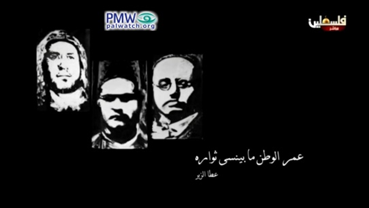
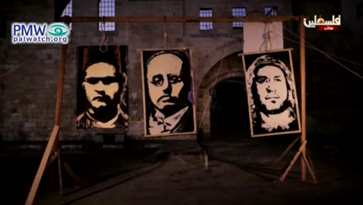
The filler ends with a quote attributed to Ataa Al-Zir, one of the three murderers:
“The homeland will never forget its revolutionaries.”
[Official PA TV Live, June 17, 2020]
Former PA Minister of Education and Fatah Central Committee member Sabri Saidam, also repeated the legend that the three murderers “competed” over who would be the first to die:
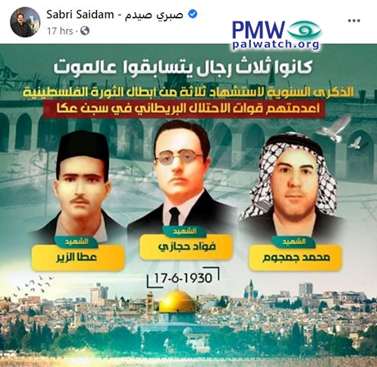
Text on image: “They were three men who competed among themselves who would die first
The anniversary of the deaths as Martyrs of three of the heroes of the Palestinian revolution
They were executed by the British occupation forces at Acre Prison
Martyr Muhammad Jamjoum
Martyr Fuad Hijazi
Martyr Ataa Al-Zir.”[Facebook page of Fatah Central Committee member Sabri Saidam, June 17, 2020]
Fatah’s Commission of Information and Culture likewise posted images of the three murderers, highlighting their status as “Martyrs”:
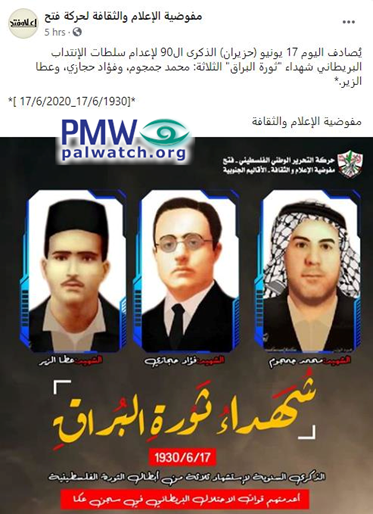
Text on image: “The Palestinian National Liberation Movement – Fatah
Commission of Information and Culture, the southern areasMartyr Muhammad Jamjoum
Martyr Fuad Hijazi
Martyr Ataa Al-ZirThe Martyrs of the Al-Buraq Revolution
June 17, 1930The 90th anniversary of the deaths as Martyrs of three of the heroes of the Palestinian revolution
The British occupation forces executed them at Acre Prison”[Facebook page of the Fatah Commission of Information and Culture, June 17, 2020]
The following are longer excerpts of the reports cited above:
Official PA TV News, on the 90th anniversary of the execution of murderers Muhammad Jamjoum, Fuad Hijazi, and Ataa Al-Zir
Official PA TV newsreader: “Today [June 17, 2020] is the 90th anniversary of the execution of the three fighters Muhammad Jamjoum, Ataa Al-Zir, and Fuad Hijazi (i.e., murderers) at the hands of the British colonialists in 1930, after the events of the Al-Buraq Revolution (i.e., the 1929 Hebron Massacre and following riots).”
Caption: “Martyrs”
Visuals: Murderers Muhammad Jamjoum, Ataa Al-Zir, and Fuad HijaziSong lyrics: “There were three men who competed among themselves over death. Their feet rose above the neck of the hangman, and they became role models.”
Official PA TV reporter: “This lamentation is not just words, but rather it remains a turning point in the history of our cause. It immortalized the pulse of the courage and defiance, and left a huge impression in eulogizing our heroes, the heroes of Red Tuesday. Muhammad Jamjoum, Ataa Al-Zir, and Fuad Al-Hijazi – 90 years have passed since their ascent [to Heaven] as Martyrs, but their sun is not setting for even one day from our history, but rather their execution at the hands of the British colonialists in 1930 remains engraved in the memory of our cause. And from June 17 of that year the sight of their execution at the citadel prison in Acre took root. The heroes of Red Tuesday wrote an eternal epic of heroism. They shaped the love of the homeland with [their] bodies, blood, and soul. They defied the prison guards and competed among themselves over the noose while happy over Martyrdom-death. The heroes competed which of them would be executed first, and they were a symbol and example of defiance and self-sacrifice, of heroism and daring. Their story began with the Al-Buraq Revolution in 1929, which spread from Hebron and Be’er Sheva in the south until Safed in the north. During [the revolution] 116 Martyrs ascended [to Heaven], and the [British] Mandate authorities arrested 900 Palestinians and issued a sentence of execution by hanging for 27 Palestinians, including the three heroes. The sentences of 24 of them were mitigated, and the execution was implemented [only] for Muhammad Jamjoum, Fuad Hijazi, and Ataa Al-Zir. The two Martyrs Muhammad Khalil Jamjoum and Ataa Al-Zir were natives of Hebron, and Martyr Ataa Al-Zir worked as a farmer. Fuad Hijazi, a native of Safed, began elementary and high school studies at the Scottish College, and his university studies were at the American University in Beirut. Our three Martyrs lived through the humiliation and oppression of the British period, which supported the Jews. They wrote their last wills a day before their execution so that the land would be stable for our processions for the sake of the liberation and struggle.”
[Official PA TV News, June 17, 2020]
Headline: “Red Tuesday: 90 years since the execution of Jamjoum, Al-Zir, and Hijazi”
“Most of us know the famous song by our poet Nouh Ibrahim, which the Palestinians have been singing for many decades and which opens with the words: ‘From Acre Prison went forth the funeral.’ This is one of dozens of songs and lamentations that were written following the execution of the three fighters Muhammad Jamjoum, Ataa Al-Zir, and Fuad Hijazi (i.e., murderers; see note below) at the hands of the British colonialists in 1930, following the events of the Al-Buraq Rebellion (i.e., the 1929 Hebron Massacre and accompanying riots) that broke out in Palestine in 1929. So who are the three heroes?
Before we get to know them one by one, we must comment on the Al-Buraq Rebellion, which was the main reason for their arrest and the death penalty to which they were sentenced. The Al-Buraq Rebellion was the name the Palestinians gave violent confrontations that broke out in Jerusalem on Aug. 9, 1929, during the period of the British Mandate in Palestine. The Muslims consider the Al-Buraq Wall (i.e., the Western Wall of the Temple Mount) an Islamic waqf (i.e., an inalienable religious endowment in Islamic law), and they have documents on the matter giving them the right to manage the site. The Jews call it ‘the Wailing Wall,’ and view it as their most important prayer site in the world (sic., the Temple Mount is the holiest site in Judaism)…
On Aug. 15, 1929 – which was the day of mourning for the destruction of the Temple according to the Jewish calendar (i.e., Tisha B’Av; see note below), and which coincided with the Muslims’ celebrations for the birthday of Prophet [Muhammad] – the Zionist right-wing Beitar Movement organized a demonstrative march within whose framework many Jews congregated in Jerusalem. They shouted ‘The wall is ours,’ and sang the anthem of the Zionist movement. The British police knew about the demonstration in advance, and sent large forces in order to protect the Jewish demonstrators. The following day the Arab leaders responded in a counter-demonstration, which went out from the Al-Aqsa Mosque towards the Al-Buraq Wall. There the participants heard a sermon from Sheikh Hassan Abu Al-Saud, who explained the dangers threatening the sites that are holy to Islam. The tension in Jerusalem grew, and violent confrontations broke out between the two sides. The confrontations spread to other cities, and Arabs in Hebron killed 67 Jewish residents of the city. In Gaza there was a small Jewish community whose members left the city with the aid of the British forces and under their protection.
The result of the confrontations, which spread from Hebron and Be’er Sheva in the south to Safed in the north, was 116 Palestinian Martyrs and 133 killed Jews, in addition to 232 wounded Palestinians and 339 wounded Jews. The Mandate authorities arrested 900 Palestinians, and sentenced 27 Palestinians to death by hanging. The sentence of 24 of them was mitigated, while the sentence of the remaining three was carried out on June 17, 1930, at the citadel prison in Acre. The three were Fuad Hijazi, Muhammad Jamjoum, and Ataa Al-Zir.1. Fuad Hassan Hijazi:
Fuad Hassan Hijazi was born in 1904 in Safed, which is in northern Palestine…
Hijazi actively participated in the Al-Buraq Rebellion in his city…
The Mandate authorities allowed Hijazi to write a letter to his family a day before his execution, and he sent his last will to the Al-Yarmouk newspaper, which published it on June 18, 1930 in his handwriting and with his signature. At the end of the letter was written: ‘The day of my hanging must be a day of happiness and joy, and it is a duty to celebrate and rejoice on June 17 every year. This day must be a historical day in which sermons are delivered and songs are sung in memory of our blood, which was spilled for the sake of Palestine and the Arab cause.’ Fuad Hijazi wrote in his last will a day before his execution: ‘If the execution of us three to any extent destabilizes the English nightmare that is befalling the honorable Arab nation, then let tens of thousands like us be executed so that our nightmare will pass completely.’2. Ataa Al-Zir:
Ataa Ahmed Al-Zir was born in the Palestinian city of Hebron in 1895. He worked in manual labor and agriculture, and was known from birth for his courage and physical strength. He actively participated in the resistance, and particularly in the Al-Buraq Rebellion in 1929…
Similarly to Hijazi, Al-Zir was also allowed to write a letter to his family. His letter, which he wrote to his mother in the peasant dialect, said: ‘Dance, mother, if news of my death reaches you. Dance and do not be sad on the day of my hanging. It does not matter what the enemy will do to my soul, mother, I am not leaving the homeland.’ …3. Muhammad Khalil Jamjoum:
Muhammad Khalil Jamjoum was born in 1902, and he was one of the fighters of the Al-Buraq Rebellion… He participated in the bloody events that broke out following the Al-Buraq Rebellion against Jewish residents… He was known for his opposition to Zionism and the British Mandate…
Jamjoum was also allowed to write a letter, similarly to his two comrades…
His letter said: ‘Now, as we stand at the gates of eternity and give our souls for the sake of the sacred homeland, for the sake of precious Palestine, we ask all the Palestinians that our blood that is spilled and our souls that will hover in the skies of this beloved land not be forgotten. Remember that we gave our souls and our skulls of our own free will, so that they would serve as a basis for the independence of our nation and its freedom. [We ask] that the nation will remain united and will persevere in its Jihad for the redemption of Palestine from the enemies.’”[WAFA, official PA news agency, June 16, 2020; June 17, 2020]
The article includes pictures of murderers Muhammad Jamjoum, Fuad Hijazi, and Ataa Al-Zir with their names underneath them.
Directly underneath this is a picture of three men being hung, clearly implying that they are Jamjoum, Hijazi, and Al-Zir. However, the picture actually shows Syrian independence leaders being hung by Turkish Ottoman forces in 1916.
